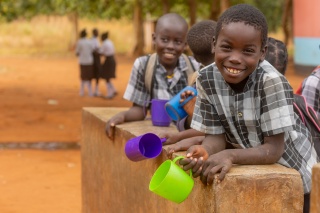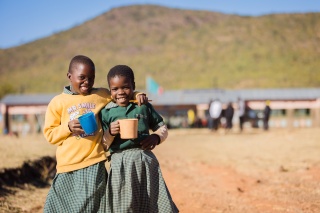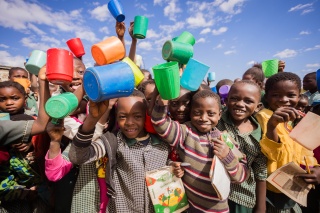Ten years of school feeding in Zambia
Providing a meal to children in their place of education is having a far-reaching impact on the welfare of communities across Zambia’s Eastern Province.
The opportunity to expand our work to Zambia first came about when I was working as Head of Programmes for the Mary’s Meals Malawi team.
Having someone with a combination of programme expertise, operations knowledge and relationship-building skills was essential. At that time, I was one of just a few people with this experience, so I was asked to lead the work and scope potential for expansion to Zambia.

The early days
When I arrived in Chipata, in Zambia’s Eastern Province, it was a completely new place for me – new people and no familiar faces. Thankfully, the Zambian people are friendly and quite similar to my kinsmen across the border.
I started everything from scratch including finding premises and establishing an office. Shortly after, I recruited the first two Mary’s Meals Zambia school feeding officers. For more than a year, I worked as Country Representative, Programme Driver, Finance Person and HR Person! While it was a very busy schedule, I learnt a lot and much of this knowledge helps me when working with various specialised teams across the global Mary’s Meals network.
Initially, we used a food supplier from Malawi called Rab Processors, but I began searching for local producers and discovered that CSB (corn and soya blend porridge) was being produced in the Chipata area, albeit on a small scale. Given the size of our programme at the time, operating in 25 schools for around 18,000 children, the small production was adequate, and we quickly began working with this local supplier. Today, we have three suppliers that serve our meals across more than 1,000 schools.
Our initial supplier still works with us and has grown its production capacity over the years. We have supported them with consistent business, enabling them to expand their operations. The second has also supported us for more than seven years, and the third for five years.

The impact of Mary’s Meals in Zambia
The poverty that pervades today in Zambia’s Eastern Province was present when I first came to the area. Food insecurity was a problem, as was hunger for school-age children. There was no active school feeding programme in Chipata when we first began serving meals. There was also no school feeding taking place in Lundazi and Mambwe. However, some erratic feeding was happening in the other districts.
Our research showed that school feeding would address a strong need in the province, especially in the districts we first singled out. There was also consensus within the Government of Zambia that Eastern Province was a good place for us to start.
Over the past 10 years, our programme has had a direct impact on the children attending the schools where our meals are served, as well as the households they come from. For example, because there is less anxiety about being hungry at school, there has been an increase in the number of children attending schools where we are feeding. Children being fed at school positively affects welfare at a household level, as parents are only occupied with providing food after school, rather than before.
Over the years, we have seen enrolment increase and improve, school attendance become more consistent and we’re seeing more learner participation in class. This was tested through a five-year impact assessment and our ongoing annual impact research work. We also believe we have had a positive impact on the local economy because, where we can, we purchase the raw materials for our programme from local smallholder farmers.
While the eradication of poverty is a long-term impact, I’m hopeful that the children who stay in school because of the feeding programme will one day be productive for themselves and their communities. We have also developed the capacities of school staff and communities to organise and implement feeding programmes and other development initiatives requiring cooperation between schools and communities.
Witnessing the dedication of volunteers such as Fatness from Kapara Primary School – who was at the initial community meeting when we presented the idea of Mary’s Meals for the school and is still there now, cooking the meals and organising other volunteers – it’s a story of genuine love, determination for community development, and human resilience. She is part of a bigger story of the people who make Mary’s Meals possible in schools, and I am so grateful to them for their contributions.

Overcoming operational challenges
Our first challenge was how to set up operations in an area where we had no prior presence. The task of connecting with the relevant authorities and convincing them that we and our work were credible was hard, but the outcome was equally as rewarding.
The second challenge was to convince the Government of Zambia and the Revenue Authority that we should be considered as a public benefit organisation and should be exempt from certain taxes on programme materials. As a new organisation, we needed to quickly gain the confidence of the Ministry of Finance and the Revenue Authority. It was not an easy task, and our initial application was rejected. It truly was a great hurdle to overcome.
Our third challenge was securing talented and experienced people to join us. As a small charity deliberately keeping costs low and therefore unable to be competitive in the labour market, it has not been easy to attract very experienced talent. This has encouraged us to develop our own people and, as a result, most of our leaders are homegrown. This process has taken time and has not always been easy, but it is incredibly rewarding, and I have full confidence in our amazing team at Mary’s Meals Zambia.

Transforming children’s lives
Over the past 10 years, I have learned many incredible stories that have touched my heart. For instance, when I hear about a young learner who says: “When I am hungry, I feel very weak. But when I have my cup of porridge, I feel my energy come back!” this confirms my belief that Mary’s Meals is having a profound impact.
And when I hear a volunteer teacher, who is helping to educate children in the same school where he studied and received Mary’s Meals, say that “the introduction of porridge changed my life from nobody to somebody”, it reassures me that school feeding has an immediate, positive impact, and contributes to long-term and lasting change in the lives of children, their households and the communities they come from.
Working with communities in Zambia’s Eastern Province for the last 10 years, we have already seen so much positive change. And, of course, with the programme going from strength to strength, and so many learners staying in school and having energy to learn, there is much more still to come.
Panji Kajani is our Country Director for Mary’s Meals Zambia. He is responsible for growing the Mary’s Meals movement in Zambia, which now provides meals to more than 400,000 children.
It costs just £19.15, €22, $25.20 USD or $31.70 CAD to provide a child with school meals for an entire school year. Read an article about how we’ve been feeding Zambia’s future for the last 10 years and learn more about how the promise of a daily enables the children we serve in Zambia to receive an education.
